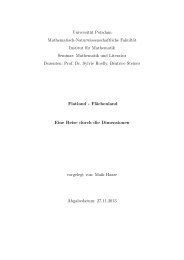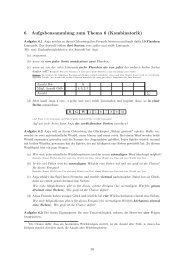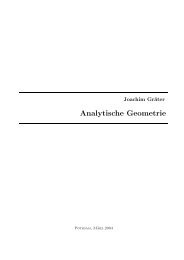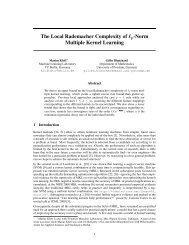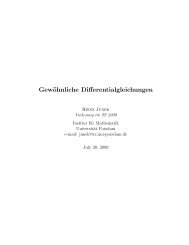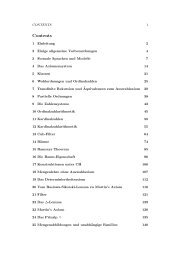Notes on integration I: The underlying convergence theorem
Notes on integration I: The underlying convergence theorem
Notes on integration I: The underlying convergence theorem
Create successful ePaper yourself
Turn your PDF publications into a flip-book with our unique Google optimized e-Paper software.
COMMUNICATIONS ON PURE AND APPLIED MATHEMATICS, VOL. x, 357-360 (1957)<br />
<str<strong>on</strong>g>Notes</str<strong>on</strong>g> <strong>on</strong> Integrati<strong>on</strong> I:<br />
<strong>The</strong> Underlying C<strong>on</strong>vergence <strong>The</strong>orem *<br />
W. F. EBERLEIN**<br />
University of Wisc<strong>on</strong>sin and New York University<br />
1. Introducti<strong>on</strong><br />
Let C denote the (algebra and lattice of) real-valued c<strong>on</strong>tinuous func-<br />
ti<strong>on</strong>s <strong>on</strong> a compact Hausdorff space S. An integral over S is a positive linear<br />
functi<strong>on</strong>al <strong>on</strong> C-that is, a mapping I of C into the real numbers satisfying<br />
(1) I(af+bg) = al(f)+bl(g),<br />
(2) I(/) 2 0 whenever f 2 0.<br />
<strong>The</strong> following propositi<strong>on</strong> dates back to Arzelal, 1885, [l] and Osgood,<br />
1897, [8] in the classical case: S = the closed finite interval (a, b) andI(f) =<br />
J: f ( WX.<br />
THEOREM. Let limn f, = f fiointwise (f,, f in C) and If,l 5 M < co for<br />
all n. <strong>The</strong>n lim,I(f,) = I(/).<br />
This result plays a paradoxical role in integrati<strong>on</strong> theory? Although<br />
the <strong>theorem</strong> c<strong>on</strong>cerns <strong>on</strong>ly c<strong>on</strong>tinuous functi<strong>on</strong>s <strong>on</strong> S, the machinery of c<strong>on</strong>-<br />
venti<strong>on</strong>al proofs stemming from Borel-Lebesgue (c. 1900, measure theory<br />
[7]) or Daniel1 (1917, functi<strong>on</strong>al extensi<strong>on</strong> [4]) involves a preliminary ex-<br />
tensi<strong>on</strong> of the mapping I to a larger class of (measurable) functi<strong>on</strong>s <strong>on</strong> S.<br />
On the other hand it is known (cf. Banach, 1937, [3] and F. Riesz, 1952, [9])<br />
that the <strong>theorem</strong> itself is a natural basis for extending I. This all but circu-<br />
lar state of affairs may account for the variety of “elementary” proofs-<br />
of varying degrees of generality-devised by such mathematicians as<br />
Riesz (1917, [9] and 1952, [lo]) and Hausdorff (1927, 1151) (disguised ex-<br />
tensi<strong>on</strong> theory), Bieberbach-Landau (1918, set of measure 0 theory [GI),<br />
Banach (1932, set theory [2]) and others.<br />
*This paper represents results obtained under the sp<strong>on</strong>sorship of the Nati<strong>on</strong>al Science<br />
Foundati<strong>on</strong>, C<strong>on</strong>tracts NSF-G2052 and NSF-G3050, and the Air Office of Scientific Research,<br />
C<strong>on</strong>tract AF lS(600)-1634.<br />
**<strong>The</strong> author is a Temporary Member of the Institute of Mathematical Sciences,<br />
New York University, for the academic year 1956-57.<br />
’Arzela’s paper actually deals with sequences of Riemann integrable functi<strong>on</strong>s.<br />
*For a discussi<strong>on</strong> of the role of the <strong>theorem</strong> in modern functi<strong>on</strong>al analysis see Wymore,<br />
1955, [12].<br />
357
358 W. F. EBERLEIN<br />
Here is a new and elementary proof of the general <strong>theorem</strong>-the basis<br />
of a neogeometric approach to integrati<strong>on</strong> over functi<strong>on</strong> spaces, with ap-<br />
plicati<strong>on</strong>s to numerical analysis and physics. <strong>The</strong> author is indebted to<br />
T. H. Hildebrandt and P. D. Lax for bibliographical criticism.<br />
2. Proof of the <strong>The</strong>orem<br />
We show first that compactness of S makes I "countably positive":<br />
If\ 5 2';"<br />
LEMMA 1. (st<strong>on</strong>es)<br />
\/,I implies r(Ifl) 5 CTI(lf,l).<br />
Proof: Given E > 0 and z in S, there exists an integer N(x) such that<br />
[ f (z) I < c:@) If, (z) 1 + E, and the inequality persists in some neighborhood U (x)<br />
of 2 because of c<strong>on</strong>tinuity. Since S is compact, the open covering (U(z))<br />
(x in S) thus obtained c<strong>on</strong>tains a finite subcovering {U(xj)). Let N be the<br />
largest iV(zi). <strong>The</strong>n If1 2 2: If,/+& implies<br />
N<br />
Wl) r 2 J(ILl)+EW<br />
1<br />
co<br />
Z'(lf~l)+E'(l)J<br />
1<br />
whence I(lf1) 5 CyI(lf,l), since > 0 was arbitrary.<br />
We require some elementary properties of the L p norms <strong>on</strong> C in the<br />
distinguished cases p = 1, 2, co. Set llfllm = sup If(x)l (x in S) and note<br />
that (1) and (2) imply<br />
(A) II(f)l 5 J(lfl) 5 Ilfllm * I(1).<br />
Thus we may first assume I( 1) > 0 (n<strong>on</strong>-trivial case) and then (<strong>on</strong> replacing<br />
I by a suitable c<strong>on</strong>stant multiple)<br />
(3) I(1) = 1.<br />
Next set (1, g) = I(fg) (f, g in C) and = (1, f)% = Finally set<br />
IlflII = I(lfl). <strong>The</strong>n:<br />
(B) I (f, g) I 5 I If1 12 * I Igl I2 (Schwarz inequality) 3<br />
(C) Ilf+slI~+fIf-gll; = 2{1lfll~+llg11;~ (parallelogram identity),<br />
(Dl Ilflll -= I(If1) = (If19 1) 5 llf112 ' lllll2 = Ilfll2><br />
(E) I If1 1; = I(f7 5 I lf21 Im = I If1 1: *<br />
3This propositi<strong>on</strong> is actually the basic axiom in St<strong>on</strong>e's theory of integrati<strong>on</strong> (1948,<br />
[I l]), while that of the <strong>theorem</strong> is essentially the basic axiom in Banach's theory (1937, [2]).
NOTES ON INTEGRATION I 359<br />
C<strong>on</strong>sider now some preliminary reducti<strong>on</strong>s of the <strong>theorem</strong> itself. We<br />
may assume f = 0 and f, 1 0 for all n (otherwise replace f, by If,-fl).<br />
Clearly L = lim sup, I(/,) 5 M exists, and we need <strong>on</strong>ly show L = 0. But<br />
we may assume limn I(f,) = L (otherwise pass to a subsequence). <strong>The</strong> pro-<br />
positi<strong>on</strong> then becomes the<br />
REDUCED THEOREM. Let: (a) f,ZieinCfor aZZn, (b) supnIlfnlIm SM
360 W. F. EBERLEIN<br />
Bibliography<br />
[l] Arzela, C., Sulla integrazi<strong>on</strong>e per serie, Rom. Acc. L. Rend., Vol. 1, 1885, pp. 532-537,<br />
56G569.<br />
[2] Banach, S., Thhorie des ophati<strong>on</strong>s lintaires, M<strong>on</strong>ografje Matematyczne, Vol. 1, Warsaw,<br />
1932.<br />
[3] Banach, S., <strong>The</strong> Lebesgue integral ia abstract spaces, a note to S. Saks, <strong>The</strong>ory of the Integval,<br />
M<strong>on</strong>ografje Matematyczne, Vol. 2, Warsaw, 1933 (G. E. Stechert Co., New York,<br />
1937).<br />
[4] Daniell, P. J., A general form of integral, Ann. of Math., Vol. 19, 1917-1918, pp. 279-294.<br />
[5] Hausdorff, F., Beweis eines Satzes w<strong>on</strong> Arzela, Math. Z., Vol. 26, 1927, pp. 136-137.<br />
[6] Landau, E., Ein Sat2 uber Riemannsche Integrale, Math. Z., Vol. 2, 1918, pp. 350-351.<br />
[7] Lebesgue, H., Leg<strong>on</strong>s sur l’intdgrati<strong>on</strong>, Gauthier-Villars et Cie., Paris, 1904, 2nd Ed., 1928.<br />
[8] Osgood, W. F., N<strong>on</strong>-uniform c<strong>on</strong>vergence and the integrati<strong>on</strong> of series term by term, Amer.<br />
J. Math., Vol. 19, 1897, pp. 155-190.<br />
[9] Riesz, F., #ber Integrati<strong>on</strong>en unendlicher Folgen. Jber. Deutsch. Math., Vol. 26, 1917,<br />
pp. 274-278.<br />
[lo] Riesz, F., and Sz.-Nagy, B., Lep<strong>on</strong>s d’analyse f<strong>on</strong>cti<strong>on</strong>nelle, Akadbmiai Kiad6, Budapest,<br />
1952.<br />
[ll] St<strong>on</strong>e, M. H., <str<strong>on</strong>g>Notes</str<strong>on</strong>g> <strong>on</strong> integrati<strong>on</strong>, Proc. Nat. Acad. Sci. U.S.A., I. Vol. 34, 1948, pp.<br />
336-342, 11. pp. 447-455, 111. pp. 483-490; IV. VO~. 35, 1949, pp. 50-58.<br />
[I21 Wymore, A. W., On Weak Compactness in Functi<strong>on</strong>al Analysis, <strong>The</strong>sis, University of<br />
Wisc<strong>on</strong>sin, Madis<strong>on</strong>, 1955.<br />
Received January, 1957.





